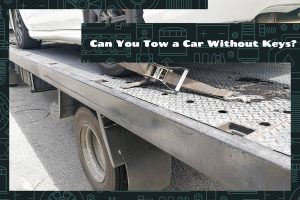Are you ready to hit the slopes in your Subaru? After all, you don’t want to get stuck in the snow or slide off the road. But can you really put chains on a Subaru?
Yes, you can, but it might not be completely necessary if your Subaru comes with Symmetrical AWD. Before installing the chains, make sure they are the appropriate size since certain models may not have enough clearance between the tires and the body of the vehicle.
In this guide, I’ll explain what chains are and what they’re used for, as well as how to size your car’s tires for chains.
What Are Tire Chains?

Tire chains are devices made of heavy steel links that wrap around a vehicle’s tires to provide better traction on snow and ice-covered roads. They are designed for use on two-wheel-drive vehicles, whereas tire cables, made of steel aircraft cables enclosed in alloy traction coils, are more common for four-wheel-drive vehicles.
There are 3 main types of tire chains: Diamond, Cable, and Alternative. Each type has different variations, but they all serve the same purpose: to improve grip and control on slippery surfaces. Chains should only be used on snow or ice, as using them on bare pavement can damage the tires and road.
Benefits of Using Chains
This section will explore the various benefits of using chains on your tires, helping you make an informed decision about when and how to use them.
1. Enhanced traction on slippery surfaces
Tire chains provide increased traction by digging into snow and ice, enabling better grip and control. This improved traction can be crucial in maintaining stability and maneuverability in challenging winter conditions, reducing the risk of accidents and ensuring a safer driving experience.
2. Improved braking performance
Tire chains can improve braking performance on slippery surfaces by increasing the contact area between the tire and the road. This additional grip allows for more effective braking, reducing stopping distances and making it easier to control your vehicle in challenging winter conditions.
3. Prolonged tire life
While tire chains can cause wear when used improperly or on bare pavement, using them correctly on snow and ice can prolong the life of your tires. The chains help distribute the force of friction more evenly across the tire, reducing the impact of the harsh winter environment on your tires and extending their lifespan.
4. Greater confidence in adverse weather
By equipping your vehicle with tire chains, you can feel more confident navigating through snowy or icy roads. This added security allows you to tackle challenging weather conditions more effectively, ensuring you can reach your destination without compromising your safety.
5. Legal compliance in specific regions
In certain areas with heavy snowfall or frequent icy conditions, local laws and regulations may require drivers to use tire chains. By equipping your vehicle with the appropriate chains, you ensure compliance with these regulations, avoiding fines or penalties while also promoting safer driving practices.
Can You Put Chains on a Subaru?
Yes, you can put chains on a Subaru, but it is generally not recommended due to Subaru’s Symmetrical All-Wheel Drive system. Many Subaru vehicle manuals explicitly state that snow chains are not recommended. Using tire chains on a Subaru can pose a risk of damaging the drivetrain.
However, if you must use chains on your Subaru, it is possible with certain precautions. For example, the 2022 Subaru Forester owner’s manual (PDF) states that it cannot use tire chains due to insufficient clearance between the tires and the body.
How to Install Chains on a Subaru

Installing tire chains on your Subaru can be a daunting task, especially if you’re doing it for the first time. Follow this step-by-step guide to ensure proper installation and enhanced safety while driving in winter conditions.
1. Read the owner’s manual
Before attempting to install tire chains on your Subaru, check your owner’s manual to see if tire chains are recommended for your specific model. Some Subaru vehicles may have clearance issues or other concerns related to using tire chains
2. Choose the right tire chains
Select tire chains that are compatible with your Subaru and its tire size. Always verify that the chains meet the specifications mentioned in your owner’s manual.
3. Lay out and position the chains
Unfold the tire chains and lay them flat on the ground, ensuring there are no tangles or twists. Drape the chains over your tires, making sure they are centered and evenly distributed. The chains should cover both the tread and the sidewalls of the tires.
4. Connect the chains
Ensure the chains are snug and tight on your tires. Some chains come with tensioners or tightening devices to help with this step.
5. Test-drive for a short distance
Drive your Subaru a short distance, approximately 100 to 300 feet, then stop and re-tighten the chains if necessary. This will help settle the chains onto the tires.
Tire Chain Alternatives
While tire chains provide excellent traction on snowy and icy roads, there are alternative options that offer similar benefits without the need for chains. Let’s explore some popular tire chain alternatives and their advantages.
1. Snow socks
Snow socks are fabric-based covers that can be fitted over the tire to improve grip on icy and snowy surfaces. They are lightweight, easy to install, and cause less damage to the road compared to traditional chains. Snow socks are also accepted in all 50 states as a tire chain alternative.
2. Traction mats
Traction mats are portable devices placed under the tires to provide additional grip on slippery surfaces. They can be used in a variety of situations, including getting unstuck from snow, mud, or sand. Unlike tire chains, traction mats do not need to be installed on the tires, making them a convenient option for emergency situations.
3. Winter tires
Winter tires, also known as snow tires, are designed specifically for cold weather conditions and offer improved traction on snow and ice. Their rubber compounds remain flexible at low temperatures, and their tread patterns are designed to provide better grip in winter conditions. While not a direct replacement for tire chains, winter tires can significantly enhance a vehicle’s performance in snowy and icy conditions.
4. All-terrain tires with 3PMSF rating
All-terrain tires with a 3PMSF (Three-Peak Mountain Snowflake) rating are designed to provide better traction on snow and ice than regular all-season tires. They are a versatile option for drivers who need improved winter performance without the need for dedicated snow tires or tire chains.
FAQs
1. Can I use chains on all four wheels?
Yes, you can use chains on all four wheels if your vehicle manufacturer allows it and if local laws permit their use. Using chains on all four wheels provides better traction and control in snowy or icy conditions.
2. Can I use chains on highways?
Yes, you can use chains on highways when the road conditions warrant their use, such as during heavy snowfall or icy conditions. However, it is essential to follow local laws and posted speed limits when using chains, as they are typically designed for lower speeds.
3. Can I reuse chains from previous seasons?
Yes, you can reuse chains from previous seasons, provided they are in good condition and still fit your tires properly. Before using them, inspect the chains for signs of wear, rust, or damage, and ensure that all links and connectors are intact.
4. Do chains damage my tires?
Tire chains, when used correctly, should not damage your tires. However, improper use or installation, driving on bare pavement, or using chains not designed for your specific tire size can cause damage to both the tires and the road. Always follow the manufacturer’s guidelines for installation and use to prevent any damage to your tires.






